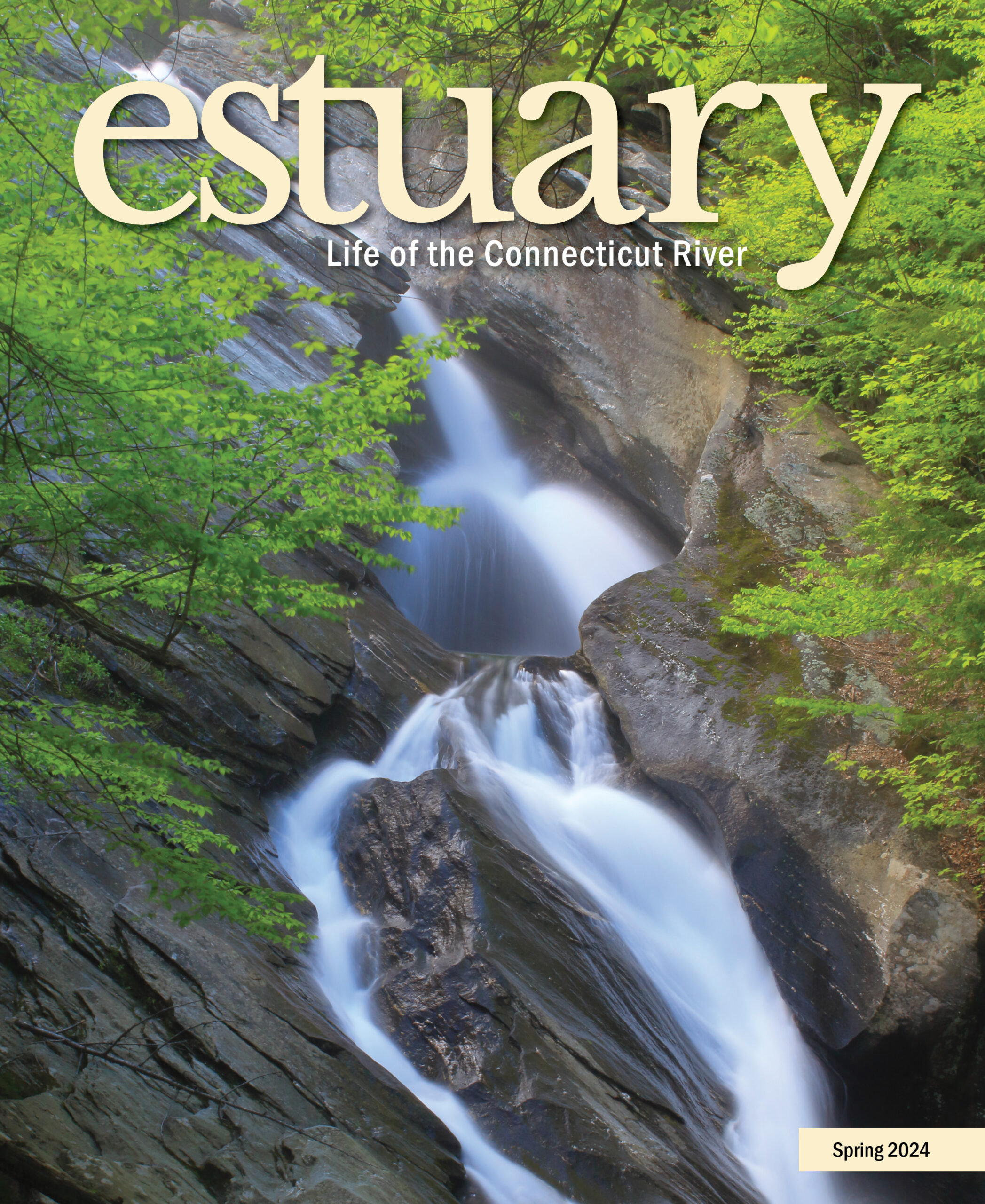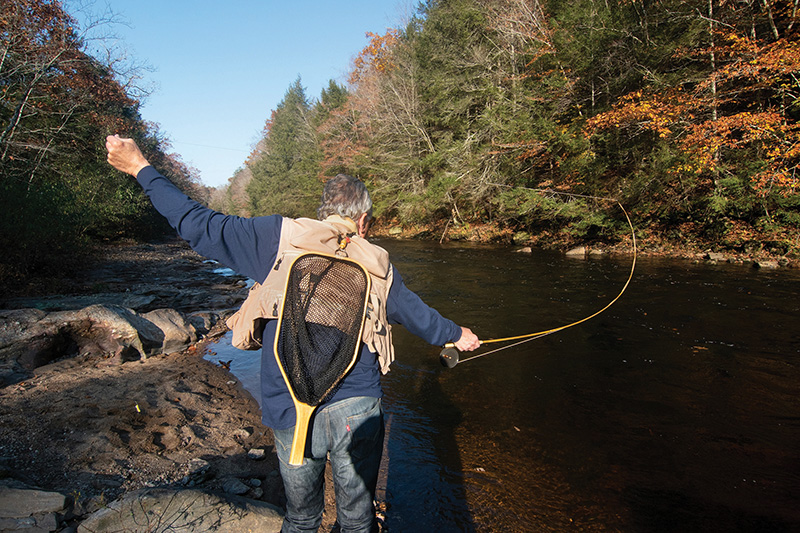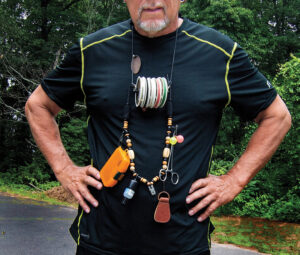 This article appears in the Spring 2024 issue
This article appears in the Spring 2024 issue
 The Eightmile River
The Eightmile River
Story and Photos by Ed Mitchell
Frequently hidden from view, the Eightmile River and its East Branch ramble through the pristine woodlands of Lyme, East Haddam, and Salem, Connecticut. This is lovely and largely undeveloped countryside. Such untamed natural beauty convinced Congress to declare both rivers “Wild & Scenic” in 2008, an honor only thirteen rivers in New England own. The Eightmile starts life in the wetlands of East Haddam, wandering thirteen miles downstream to join the Connecticut River at Hamburg Cove, four miles north of the I-95 Baldwin Bridge. The East Branch originates near Peck’s Meadow Pond, just west of Route 85 in Salem. From there it meanders south and west to unite with the Eightmile near the intersection of Route 156 and Salem Road.
The Eightmile is stocked in March and again in April with about 3,000 trout. The East Branch is stocked at the same time with upwards of 1,000 fish. In both cases, roughly a third of the trout are twelve inches or larger. Neither river is stocked again in the fall, making it best to fish early in the year. Please remember that from March 1 to 6 a.m. on the second Saturday in April trout fishing in rivers is catch & release only. After that the limit is five fish a day.
Access
The angling access is complicated, given that the surrounding lands have several titleholders, including the Lyme Land Trust, The Nature Conservancy, the Town of Lyme, the State of Connecticut, and various landowners. As a result, I will only discuss spots where I’m fairly certain you can wet a line.
Devil’s Hopyard State Park in East Haddam, on Route 434, hosts the most popular fishing spots on the Eightmile. High on the list is Chapman Falls, a scenic postcard setting that receives a heavy dose of fish. It is often mobbed, however, and I urge avoiding it. Instead, head south along Hopyard Road. Go slow; the road is very narrow. The river is stocked in several locations down to Muddy Brook. Easy parking is found in picnic areas on the east side, offering quick access to good-looking water. Work your way downstream of these recreation areas to get away from the crowds.
Continuing southward, Hopyard Road meets Route 82. Turn right, and just ahead turn left onto Route 156 south. A short distance down, bear left onto Salem Road, which hugs the East Branch of the Eightmile. On your left, just over a mile up from Route 156, is a parking lot for the Eightmile Wildlife Management Area. The land across the street is owned by the State of Connecticut. It is public and stocked. Cut across the field to the river or walk up the street to an old road entering on the right side. A short hike brings you to a wooden bridge over the East Branch. You can fish your way downstream from there. A smidge further up toward Salem the East Branch swings beside the road. The state stocks along here. Park carefully on the east side, avoiding any land that is posted. Ahead you’ll find the East Branch running under a bridge on the East Haddam/Salem Town line. The river is stocked at the bridge. Park carefully on the west side of the road only.
Okay, let’s safari onward. Head back to Route 156 and bear left. A half-mile down on the right side of the road is a grassy strip where anglers frequently park. A trek downhill through the forest brings you to the Eightmile and some good-looking water both up- and downstream. From here our next stop is nearby. A half-mile farther south on 156, bear right on MacIntosh Road. The Eightmile lies directly ahead, traveling under the new John H. Mazer Bridge. At this point you have two angling opportunities. There is a dirt road just prior to the bridge on your right side. A bit of ground clearance is required, but this short road affords access to what is called the “Swimming Hole.” It is likely the largest pool on the river, and a popular fishing spot. Be sure to check out the riffle at the head of the pool too. Back at the bridge there is a dirt parking area about 50 yards west. Walking back to the river you can fish at the bridge or head downstream. The land on the west bank is public.
Casting Tips
Small, heavily wooded streams have a magic allure. With silence and solitude, they offer a sense of wilderness. To be successful however, you must refine your tackle and tactics. Overhead casting is impractical here. So leave your 8- and 9-foot fly rods home. Instead, a short, slow action rod does the trick. By short I mean a rod 7.5-feet or less, capable of handling a 4-wt or lighter fly line. Why slow action? Slow action rods excel at roll casting, which is essential in tight quarters. They also excel at a very useful and less known casting method called the “Bow & Arrow” cast. Here again no backcast is required. Rod in hand, extend your casting arm over the stream with a small amount of fly line outside the tip. With your opposite hand grasp the midsection of the leader, then raise that arm high and away from you while pulling backward. With the rod bent, point it at your target. Releasing the leader allows the rod to propel the fly to the water. Like all casting methods, this takes practice to master. Avoid a long leader at first. And don’t be tempted to grasp the fly rather than the leader. You may end up hooking yourself.

In tight quarters, a bow & arrow cast works great.
Gear
Chest waders are only occasionally helpful on the Eightmile—most of the water can be fished with hip boots. Small streams rarely require you to carry a mountain of fly gear. Consider leaving your heavy fly-fishing vest at home. A fly-fishing lanyard will do just fine. They are lightweight, comfortable and can carry the essentials: tippet spools, a fly box, forceps, dry fly dressing, and a few strike indicators for nymph fishing. Expect small stream trout to be wary. Move stealthily, wear dull colored clothing, and crouch down to fish.

A fly-fishing lanyard can carry everything you need.
Love a challenge?
Follow me to the river one more time. Not far from MacIntosh Road there is stretch of the Eightmile where no trout are presently stocked. Why fish there? This part of the river is one of only eight designated sea-run trout sections in Connecticut. For many years the State of Connecticut stocked 4,000 sea-run brown trout parr each year. These parrs migrate to sea, grow large, and then return to spawn. How big do they get? The state record is over ten pounds. And there is still an outside chance you might lock horns with one.
From MacIntosh Road head south on Route 156 for 1.5 miles. Then bear right on Joshuatown Road, and a moment later Joshuatown Bridge appears. On your right there is off-road parking immediately prior to the bridge. From here you can fish your way upstream. The banks are steep, requiring chest waders; a wading staff is handy too. Keep to the water or stay close to the bank as both sides of the river are private. This part of the river rises and falls with the tides entering from Hamburg Cove. And you can expect sea-runs to be most aggressive when those tides are moving. Try fishing in the fall and early winter here, especially on dark, overcast days. The season for sea-run brown trout in Connecticut is open year-round with a maximum creel of two fish per day at a minimum size of fifteen inches.
Final Notes
There are alewife and blueback herring in the Eightmile. If you hook one release it immediately. They are illegal to keep. And always check yourself for ticks.
Ed Mitchell is the author of four books about fly-fishing and has written for many magazines. He has over 40 years of experience in both fresh and saltwater fly-fishing.
